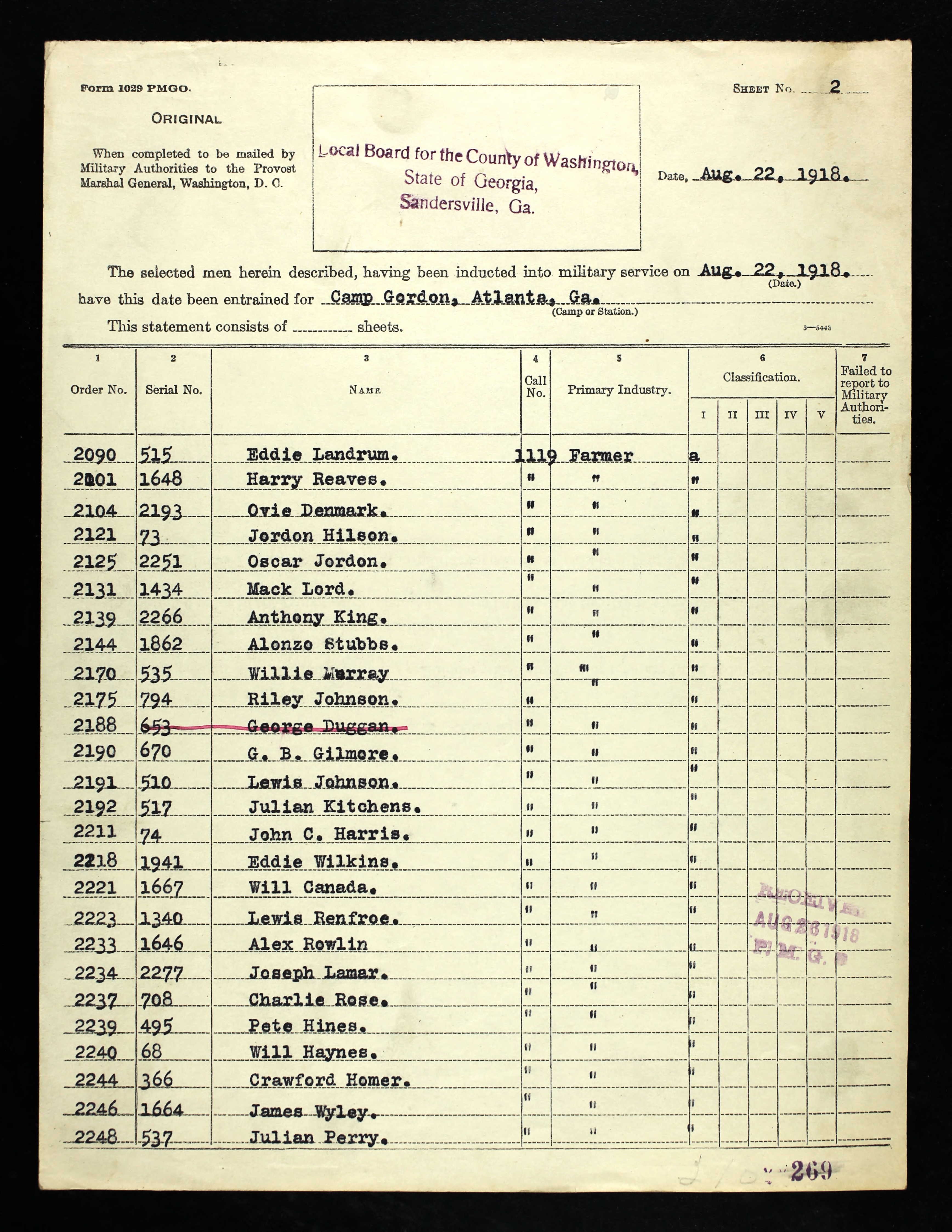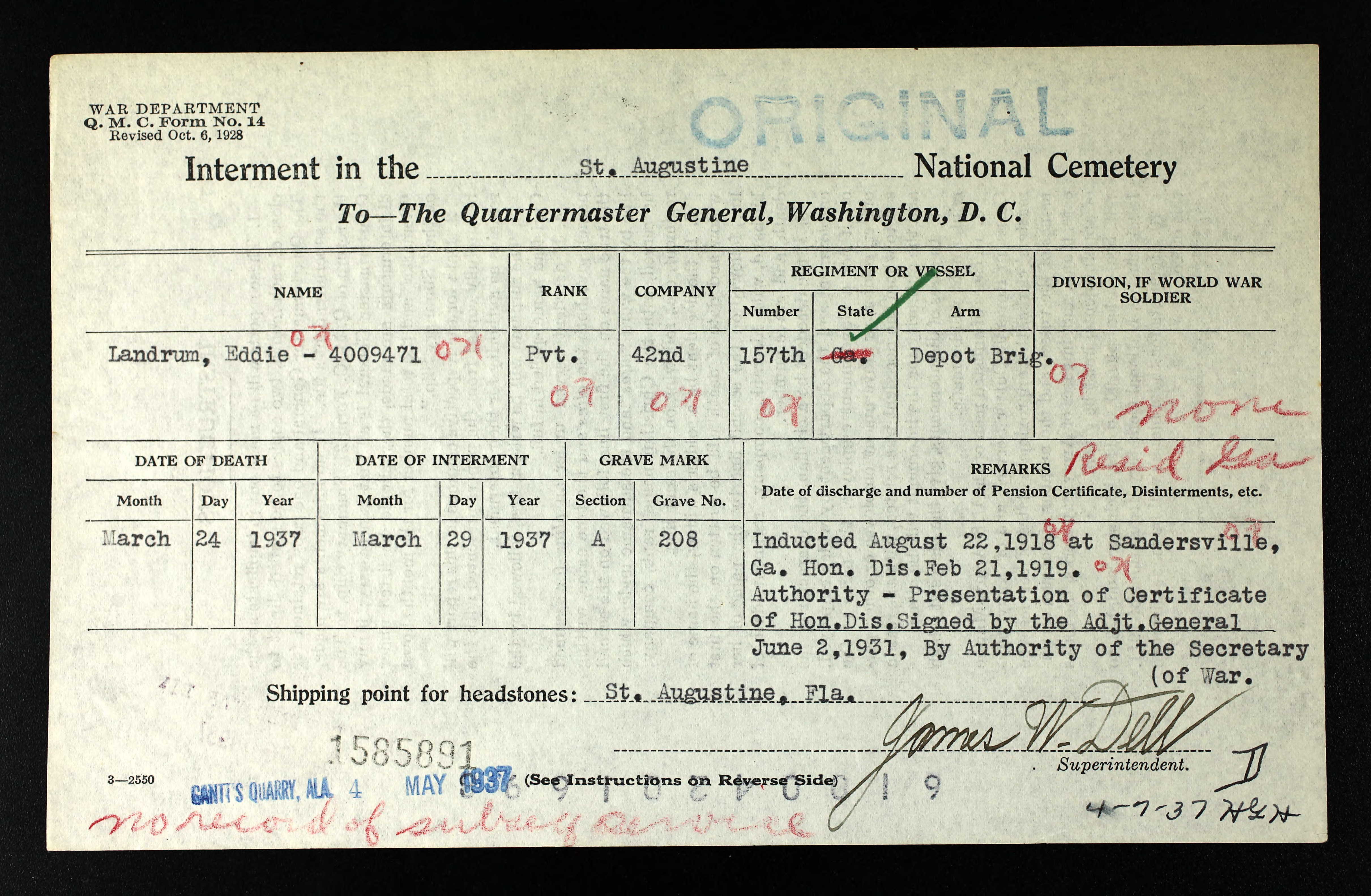Elijah L. (Eddie) Landrum (July 3, 1899–March 24, 1937)
By Gramond McPherson
Early Life
Elijah L. Landrum, known commonly as Eddie,was born in Sandersville, Georgia, on July 3, 1899, to Edmund and Argie Landrum. Before joining the Army, Landrum lived in Sandersville, working as a farmer, a common occupation of African American men in the rural South. The vast majority of black Southern men worked as tenants, sharecroppers, or wage farm hands. While many hoped to one day own their own land, debt to landlords and store creditors only increased their indebtedness to white Americans and few achieved land ownership.1
Military Service
After the US entered World War I in 1917, Congress passed the Selective Service Act to increase the manpower of the military through conscription. The first draft registration took place on June 5, 1917, requiring all men in the US between the ages of twenty-one and thirty-one to register. The second registration took place a year later on June 5, 1918, for individuals who turned twenty-one after June 1917.2 Landrum, only seventeen and eighteen in 1917 and 1918 respectively, registered for the draft, listing his birth year as 1895 to make himself eligible to register. African Americans carried multiple motivations in registering for military service. For some, soldiers often earned more in the military—usually thirty dollars per month—than working as laborers or farmers, a significant financial benefit to many black families. Other African Americans hoped that by serving in the military and showing their bravery and loyalty to America, they would be rewarded with equal rights and fair treatment by white society. Thus, thousands of blacks registered, even willing to lie about their age, like Landrum, to join the war effort.3
Overall, the military drafted one-third of black registrants compared to one-fourth of white registrants. On August 22, 1918, Landrum was drafted into the Army as a Private and went to train at Camp Gordon, Georgia near Atlanta, as shown here, as part of 157th Depot Brigade. The brigade originally formed in September of 1917, before moving to Camp McClellan in Alabama by September of 1918. The 157th returned to Camp Gordon in December of 1918. Depot brigades held soldiers during the initial period of processing, training and indoctrination into the Army before being assigned to an operational unit. The War Department, feeling pressure from whites, especially Southerners who feared race riots, sought to utilize black soldiers in non-threatening roles to meet both military and domestic needs. Thus, most black soldiers were assigned to Quartermaster and Engineering units which provided labor support. However, before Landrum could be assigned to an operational unit, the war ended with the armistice on November 11, 1918. Landrum remained with the 157th at Camp McClellan and Camp Gordon until his discharge from the Army on February 21, 1919.4
Post Service Life
Landrum was married to his wife Ethel and the couple eventually settled in Saint Augustine, Florida, where Landrum continued working as a farmer. At the time of his death on March 24, 1937 in Saint Augustine, he farmed on the land of a Mr. Lawson. Landrum was interred on March 29, 1937 at the St. Augustine National Cemetery in Section A, Grave Number 208, as shown here.5
Endnotes
1 Leon F. Litwack, Trouble In Mind: Black Southerners in the Age of Jim Crow (New York: Alfred A. Knopf, Inc., 1998) 128-130; “Georgia, World War I Service Cards, 1917-1919,” database, Ancestry.com (https://ancestry.com : accessed July 12, 2018), entry for Eddie Landrum; “1930 United States Census,” database, Ancestry.com (www.ancestry.com : accessed July 12, 2018), entry for Edmund Landrum, ED-0007, Sun Hill, Washington, Georgia.
2 Jennifer D. Keene, World War I: The American Soldier Experience (Lincoln, NE: University of Nebraska Press, 2011), 33-37; “World War I Draft Registration Cards,” National Archives, accessed June 27, 2018, https://www.archives.gov/research/military/ww1/draft-registration.
3 Georgia, World War I Service Cards,” Ancestry.com, Eddie Landrum; Keene, World War I, 37, 189; Nina Mjagkij, Loyalty in Time of Trial: The African American Experience During World War I (Lanham, MD: Rowman & Littlefield Publishing, Inc., 2011), 81.
4 “U.S., Lists of Men Ordered to Report to Local Board for Military Duty, 1917–1918.” database, Ancestry.com (http://www.ancestry.com : accessed July 12, 2018), entry for Eddie Landrum; Georgia, World War I Service Cards,” Ancestry.com, Eddie Landrum; Keene, World War I, 33-37, 95; Robert J. Dalessandro and Gerald Torrence, Willing Patriots: Men of Color in the First World War (Atglen, PA: Schiffer Publishing Ltd., 2009), 157. Also, Florida Department of Military Affairs, “Section A,” in St. Augustine National Cemetery Index and Biographical Guide, (St. Augustine, FL: State Arsenal, St. Francis Barracks, n.d.), 73, http://ufdc.ufl.edu/UF00047708/00001/74x; “U.S. National Cemetery Interment Control Forms, 1928-1962,” database, Ancestry.com (https://ancestry.com : accessed July 12, 2018), entry for Eddie Landrum.
5 “U.S. National Cemetery Interment Control Forms,” Ancestry.com, Eddie Landrum; “Florida Death Certificates, 1877-1939,” database, FamilySearch.org (https://www.familysearch.org : accessed July 12, 2018), entry for Eddie Landrum.
© 2018, University of Central Florida




